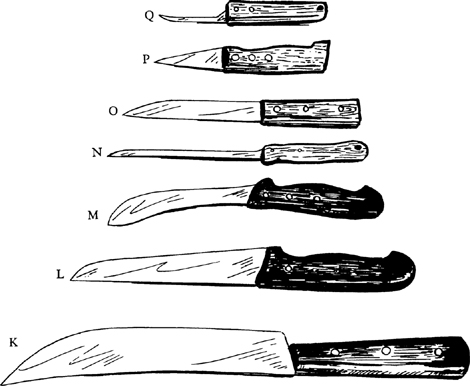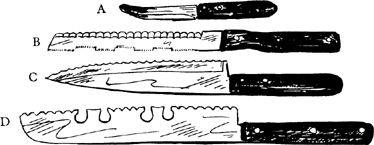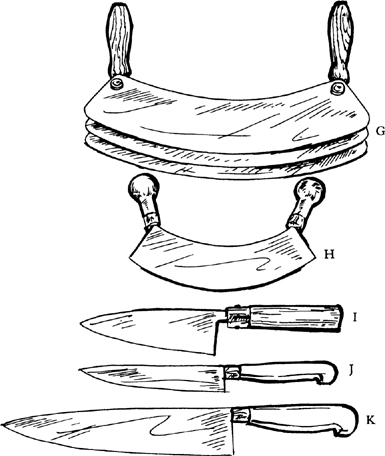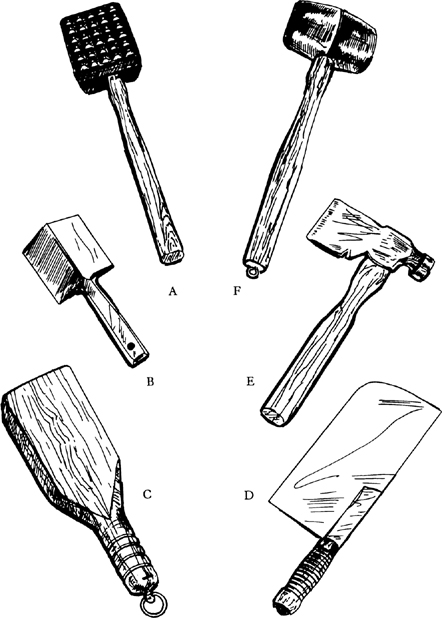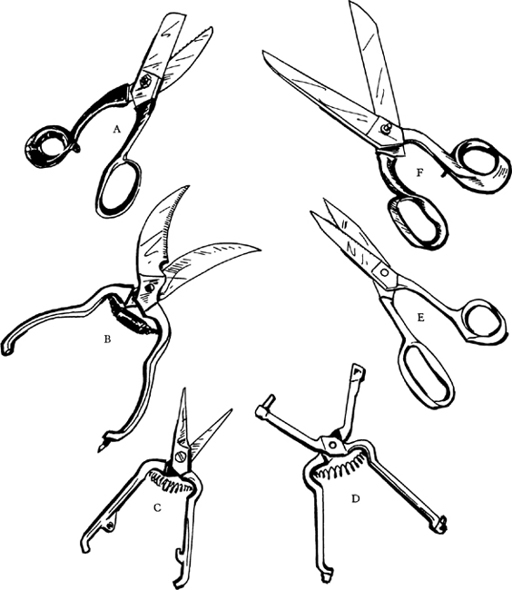Mastering the Art of French Cooking, Volume 2 (220 page)
Read Mastering the Art of French Cooking, Volume 2 Online
Authors: Julia Child

IMPLEMENTS—KNIVES
Very sharp knives are the mark of the serious cook, and continual use of the butcher’s steel will keep them razor sharp. Carbon steel knives are preferred by most chefs, but there are stainless knives that will sharpen easily too.
The Central Hoard
The straight-edged, wedge-shaped cook’s knife (C,D,E,F,G,H) is the all-purpose shape for chopping, slicing, paring, and general cutting; you will need at least three, from the 2- to 3-inch blade for paring and small minces to the 10- to 12-inch blade for chopping and rapid slicing. Curved blades (A and B) are good for paring. A professional butcher’s steel (J) with blade 10 to 12 inches long is the best sharpening equipment. A larding
needle (I) is indispensable for larding meat.
Slicers, Carvers, and Boners
Slicing, carving, and boning knives have curved blades. Here is the slicing scimitar (K), and two other slicing shapes (L and M). The stubby knife (P) and its longer companion (O) are boning knives, as is the very thin knife known as a chicken sticker (Q) with its short blade; the longer-bladed version (N) is a Norwegian herring filleter, which is also useful for slicing off pork rinds and for cutting thin sheets out of pork fat.
Serrated Sawers
Serrated knives include the curved grapefruit knife (A), the bread knife (B), the all-purpose slicer (C), the frozen-food cutter (D), the ham slicer, which also does smoked salmon (E), and the vicious-looking French meat slicer (F), which is, in addition, very good with slab bacon.
Choppers and Rockers
The traditional chef’s knives (J and K) are for general chopping, as illustrated in Volume I, page 27. The Japanese version (I) works equally well. The two rockers (G and H) are marvelous for mushrooms and parsley, particularly the 3-bladed professional model.
BASHERS, BLUDGEONS, AND BLUNT INSTRUMENTS
For whacking up turkey carcasses, chopping bones, and flattening cutlets, here is a choice of weapons. The meat tenderizer with its cast-aluminum head has waffled sides for tenderizing (A) and smooth sides for flattening cutlets; you can also use it as a hammer, although the rubber-headed hammer that you can buy at any good hardware store (F) is less noisy. The French cleaver,
feuille à fendre
(D), or an ordinary hatchet (E) are for whacking carcasses or bones, and a hammer helps. The French cleaver-tenderizer,
batte à côtelettes
(B), is a useful instrument, and the wooden British basher (C) is for flattening cutlets that are held between sheets of waxed paper.
SCISSOR ACTION
Heavy shears for cutting fish fins, gristle, and rib cages are the serrated French pair (A) and the heavy utility model (F), also French. Poultry shears with their curved blades (B) are useful on occasion, as are the sharp-pointed lobster shears (C). General purpose stainless kitchen scissors with take-apart blades (E) can go into the dishwasher. The scissor-action
cherry or olive pitter (D) is invaluable when you have those jobs to do.



